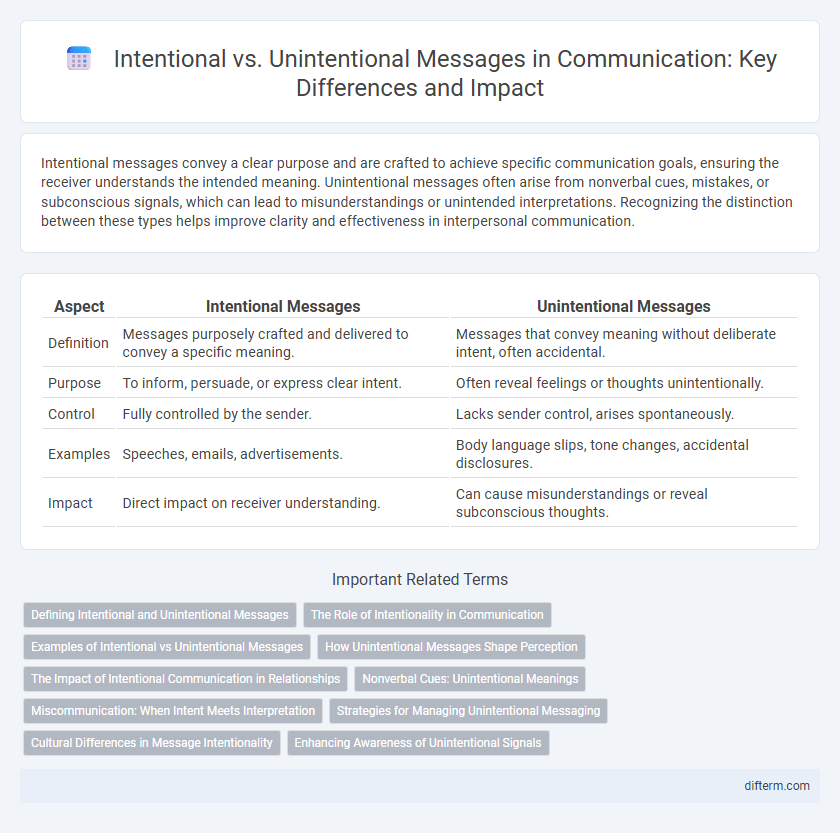Intentional messages convey a clear purpose and are crafted to achieve specific communication goals, ensuring the receiver understands the intended meaning. Unintentional messages often arise from nonverbal cues, mistakes, or subconscious signals, which can lead to misunderstandings or unintended interpretations. Recognizing the distinction between these types helps improve clarity and effectiveness in interpersonal communication.
Table of Comparison
| Aspect | Intentional Messages | Unintentional Messages |
|---|---|---|
| Definition | Messages purposely crafted and delivered to convey a specific meaning. | Messages that convey meaning without deliberate intent, often accidental. |
| Purpose | To inform, persuade, or express clear intent. | Often reveal feelings or thoughts unintentionally. |
| Control | Fully controlled by the sender. | Lacks sender control, arises spontaneously. |
| Examples | Speeches, emails, advertisements. | Body language slips, tone changes, accidental disclosures. |
| Impact | Direct impact on receiver understanding. | Can cause misunderstandings or reveal subconscious thoughts. |
Defining Intentional and Unintentional Messages
Intentional messages are communications deliberately crafted and sent with a specific purpose or goal in mind, often involving conscious word choice and tone to influence the receiver. Unintentional messages occur without deliberate intent, often revealed through body language, tone, or subconscious verbal cues that can convey emotions or attitudes inadvertently. Understanding the distinction between intentional and unintentional messages is crucial for effective communication, as it helps in interpreting the true meaning behind spoken or written words.
The Role of Intentionality in Communication
Intentionality in communication shapes the clarity and effectiveness of message delivery, as deliberate messages are crafted with a specific purpose and audience in mind. Unintentional messages, often conveyed through body language or tone, can influence interpretation without conscious control, affecting interpersonal dynamics. Recognizing the distinction between intentional and unintentional communication enhances understanding and reduces misunderstandings in both personal and professional interactions.
Examples of Intentional vs Unintentional Messages
Intentional messages include explicit emails, formal presentations, and scheduled meetings where the sender deliberately conveys information. Unintentional messages arise from body language, tone of voice, or accidental text errors that reveal emotions or attitudes without conscious effort. For instance, a raised eyebrow during a conversation unintentionally signals skepticism, while a clearly written report intentionally shares data insights.
How Unintentional Messages Shape Perception
Unintentional messages reveal underlying attitudes and emotions that explicitly crafted communication often conceals, significantly shaping how others perceive intentions and authenticity. Nonverbal cues such as facial expressions, tone of voice, and body language can convey more genuine feelings than spoken words, influencing trust and relationship dynamics. These spontaneous signals often have a stronger impact on impression formation, affecting both personal and professional interactions.
The Impact of Intentional Communication in Relationships
Intentional communication fosters clarity, trust, and deeper emotional connections in relationships by purposefully conveying thoughts and feelings. It reduces misunderstandings and strengthens mutual respect by ensuring messages align with the sender's true intentions. This purposeful exchange plays a critical role in building long-term relationship satisfaction and resilience.
Nonverbal Cues: Unintentional Meanings
Nonverbal cues often convey unintentional meanings that can significantly impact communication, such as body language, facial expressions, and tone of voice. These subtle signals may reveal true emotions or attitudes despite the spoken message, influencing how the message is interpreted. Understanding unintentional nonverbal communication is crucial for decoding sincerity and preventing misunderstandings in interpersonal interactions.
Miscommunication: When Intent Meets Interpretation
Miscommunication occurs when the sender's intentional message is misinterpreted by the receiver, leading to distorted understanding or confusion. Intentional messages rely on clear expression and context, while unintentional messages often arise from unconscious cues or ambiguous signals. Effective communication depends on aligning intent with accurate interpretation to prevent misunderstandings.
Strategies for Managing Unintentional Messaging
Strategies for managing unintentional messaging emphasize active listening and seeking clarification to prevent misunderstandings and misinterpretations. Implementing feedback loops and fostering an open communication culture helps identify and address ambiguous or unintended signals promptly. Using clear, concise language and nonverbal cues aligned with intended messages reduces the risk of unintentional communication errors.
Cultural Differences in Message Intentionality
Cultural differences significantly influence the perception of intentional versus unintentional messages, as high-context cultures often rely on implicit communication where meaning is inferred rather than explicitly stated. In contrast, low-context cultures prioritize directness and clarity, interpreting messages as intentional when clearly articulated. Misinterpretation arises when communicators from differing cultural backgrounds ascribe intentionality to ambiguous messages based on their own cultural norms, affecting intercultural communication effectiveness.
Enhancing Awareness of Unintentional Signals
Unintentional signals in communication often reveal true emotions and underlying attitudes that intentional messages might conceal, making awareness crucial for accurate interpersonal understanding. Enhancing sensitivity to nonverbal cues such as facial expressions, tone variations, and body language helps decode these unconscious messages. Training in emotional intelligence and active observation significantly improves the ability to interpret unintentional signals, fostering more effective and empathetic communication.
intentional vs unintentional (messages) Infographic

 difterm.com
difterm.com